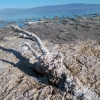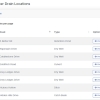
Habitat disruption around drainage structures is often subtle at first, and many of the earliest signs tend to appear during ordinary field work rather than during formal environmental surveys. Because highway departments and public works crews encounter these locations regularly, they are in the best position to detect problems before they escalate. Teaching staff how to recognize early indicators of stress in and around stormwater assets can help protect streams, wetlands, and downstream habitats. It can also prevent expensive repairs later and support compliance with environmental regulations. When crews understand what to look for, routine maintenance becomes an important part of watershed stewardship rather than a simple inspection or cleaning task.
One of the most common signs of habitat disruption is the onset of bank instability. While some erosion is natural, sudden widening of channels, fresh slumps in soil, and exposed roots near culverts or outfalls often suggest that flows are exceeding what the receiving stream can handle. Undersized or damaged structures may force water to scour the downstream bed or banks, carving out deeper channels and degrading habitat for fish and macroinvertebrates. Crews should pay attention when a channel takes on a sharp, unnatural shape or when sediment collects in areas that used to be free flowing. These observations can help engineers determine whether a structure needs repair, resizing, or modification to restore more stable conditions.
Another indicator involves sedimentation patterns that differ from the natural character of the stream. Heavy deposits of sand, silt, or road material immediately below an outlet usually signal that stormwater flows are carrying too much sediment. This can blanket riffles, fill in pools, and smother spawning areas. Crews can also look for unnatural mounds of fine material at the inlets of basins, pipes, or swales, which may show that upstream erosion is occurring somewhere else in the system. When workers encounter sediment plumes that extend far downstream, it is helpful to take notes about the color, grain size, and thickness. Even simple observations provide environmental staff with valuable clues about where the problem began.
Changes in vegetation offer additional insight. Healthy stream corridors rely on a mix of native grasses, shrubs, and trees that stabilize the banks and offer shade. If crews notice dead or dying vegetation near drainage outfalls, they should consider whether stormwater discharges contain contaminants like salt, hydrocarbons, or nutrient laden runoff. The sudden appearance of invasive plants can also reveal habitat stress. Species such as Japanese knotweed, phragmites, or purple loosestrife tend to dominate disturbed areas where native species have been weakened. Their presence around drainage structures often signals that flow patterns have changed or that soils have been disturbed by high velocity discharges. Simply noting when these species appear helps managers track the spread and plan appropriate control measures.
Water quality changes are another category of warning signs that crew members can identify with basic training and careful observation. Unusual colors, strong odors, oily sheens, or persistent foam often indicate contamination that disrupts aquatic habitat. Crews should also note water temperature. If the discharge from a culvert or pipe feels noticeably warmer than the receiving water, that temperature difference may harm cold water species downstream. Even without specialized equipment, workers can detect trends that warrant follow up sampling by environmental staff. It is important to record the time of day, recent weather, and approximate flow rate since these conditions influence water quality and help determine whether the problem is ongoing or temporary.
Wildlife behavior can provide clues as well. Streams that once supported fish or amphibians may become quiet and barren when flow is blocked by a perched culvert or when sediment fills pools that offered shelter and feeding areas. If crews see stranded fish upstream of a culvert or observe that water drops sharply from the outfall lip, it may signal a fish passage barrier. Sudden declines in the presence of frogs, crayfish, or other small species also point to habitat stress. Conversely, the unexpected presence of urban tolerant species such as rats or nuisance birds around a stormwater structure can indicate that food sources or waste materials are accumulating in ways they should not.
Finally, crews should pay attention to structural defects that indirectly harm habitat. Cracked pipes, failing headwalls, undermined culvert inlets, and displaced riprap can alter stream flow in ways that accelerate erosion or cause backwater conditions that drown vegetation. When workers notice seepage around joints or soil voids forming along the outer edges of a structure, those conditions can quickly change the hydrology of the site. Even minor defects have ecological implications, especially during heavy storms when flows rise and interact with weakened infrastructure.
Recognizing habitat disruption does not require technical expertise. What it does require is awareness, consistency, and a basic understanding of how healthy stream corridors should look and behave. By encouraging field crews to pay attention to erosion patterns, vegetation changes, water quality signals, and wildlife activity, municipalities strengthen their ability to protect watershed health. Every observation a crew member makes during a routine inspection or maintenance task becomes part of a larger picture that guides responsible stormwater management. This approach supports compliance, reduces long term costs, and helps preserve the ecological integrity of the waterways that flow through our communities.
 Wetlands are often described as the kidneys of the watershed because they filter, slow, and transform the water that passes through them in ways that …
Wetlands are often described as the kidneys of the watershed because they filter, slow, and transform the water that passes through them in ways that …
 Field inspections of catch basins, manholes, culverts, and outfalls form the foundation of responsible stormwater management. These routine checks giv…
Field inspections of catch basins, manholes, culverts, and outfalls form the foundation of responsible stormwater management. These routine checks giv…
 Habitat disruption around drainage structures is often subtle at first, and many of the earliest signs tend to appear during ordinary field work rathe…
Habitat disruption around drainage structures is often subtle at first, and many of the earliest signs tend to appear during ordinary field work rathe…
 Harmful algal blooms have become one of the most pressing water quality problems in many regions, and their rise has been linked to a complicated blen…
Harmful algal blooms have become one of the most pressing water quality problems in many regions, and their rise has been linked to a complicated blen…
 The Salton Sea is one of California’s most unusual and tragic landscapes, a place shaped by accident, transformed by ambition, and ultimately pu…
The Salton Sea is one of California’s most unusual and tragic landscapes, a place shaped by accident, transformed by ambition, and ultimately pu…
 *The screenshots used in this article are from Roadwurx, an asset management software created for road maintenance departments. Managing a town’…
*The screenshots used in this article are from Roadwurx, an asset management software created for road maintenance departments. Managing a town’…